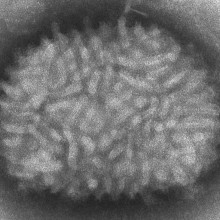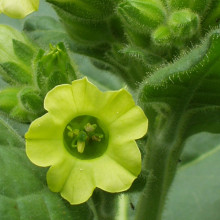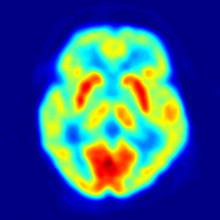In this NewsFlash, we find out how infected cells increase the rate of infection, how plants choose their pollenators and why human memories are stored in a grid. Plus, solving one of the mysteries of Madagascar!
In this episode

Infected cells bounce away incoming viruses to accelerate spread
Scientists have discovered a trick used by some viruses to speed up the rate at which they spread - infected cells bounce incoming viruses away towards new cells.
Using video recordings, Imperial-based virologist Geoff Smith and his colleagues were able to watch as vaccinia virus, a member of the poxvirus family that was used to eradicate smallpox,  infected a sheet of cultured cells under the microscope.
infected a sheet of cultured cells under the microscope.
By measuring how quickly healthy cells adjacent to an infected cell began to show signs of infection, the team were able to calculate the rate at which the vaccinia virus was spreading. It turned out to be at least four times faster than it ought to be.
Previously, scientists had thought that viruses emerging from an infected cell would infect the adjacent surrounding cells, which would then in turn infect their neighbours, and so on, causing the infection to spread out radially. But the video sequences showed that this cannot be the case. In fact, infected cells were popping up several cells away from the nearest infected neighbour.
By labelling different components of the cells and the viruses the team discovered that when a cell is infected by the virus it adds two viral proteins, called A33 and A36, to its surface, which marks it as having been "hit". If a new virus then tries to enter a cell marked in this way, the two proteins trigger the cell to eject the virus using a structure known as an actin tail, which resembles a molecular spring. This bounces the virus off in the direction of other cells that may not yet have been infected.
The labelling experiments even revealed that the same virus particle can be relaunched in this way several times! The discovery is exciting because, as the researchers point out in their paper in Science, many other viruses, including human pathogens like the cold sore agent,herpes simplex, spread across cells at the same rate as vaccinia.
This suggests that other viruses might use the same trick, which might therefore be a important target for future antiviral drugs.

Crafty plants pick and choose their pollinators
Plants get up to all sorts of clever tricks to persuade animals to pay a visit and pollinate their flowers.
Many animals are tempted by delicious smells and a reward of sugary, energy-rich nectar. But what if those visiting animals don't just take away their nectar reward - pollinating the plant in the process - but also leave behind a clutch of hungry, plant-munching offspring?
A new study has shown how some plants have come up with an ingenious solution.  They re-programme themselves to attract an alternative pollinator that doesn't produce herbivorous youngsters.
They re-programme themselves to attract an alternative pollinator that doesn't produce herbivorous youngsters.
Publishing in the journal Current Biology, Ian Baldwin from Max Planck Institute for Chemical Ecology in Germany and colleagues focus on a species of tobacco plant - Nicotiana attenuata - which responds to the spit of hawkmoth caterpillars and three days after an infestation begin to produce flowers in the morning instead of at night when the hawkmoths are at large.
Observing thousands of tobacco plants in the wild, the researchers discovered that following an attack of hawkmoth caterpillars, the flowers don't open as wide and produce less sweetly scented nectar. But that doesn't bother the day-flying hummingbirds, which begin to arrive and take on the role of chief pollinators. The team also studied genetically modified tobacco plants that lack a key hormone, called jasmonate, which is known to trigger a range of other plant defence mechanisms.
Unlike the wild plants, the jasmonate-free plants did not change the timing of their flowering when caterpillar spit was rubbed into a cut leaf. But they did respond when they were sprayed with the hormone, revealing the key role jasmonate plays in the chemical pathway between caterpillar attack and flowering.
Why do the plants bother attracting moths in the first place, instead of using harmless hummingbirds all the time? It seems likely that despite laying hungry caterpillars, the moths are more efficient pollinators and can be attracted from miles around. Meanwhile, hummingbirds don't travel as far and they ay they visit flowers tends to lead to more inbreeding within individual plants.
All in all, the best strategy for these tobacco plants is to use the reliable moth pollinators up until their hungry young come along. Then it pays to switch strategies and start attracting hummingbirds instead: very clever indeed.

Human spatial memory based on a grid system
Scientists have discovered that, at least when it comes to finding our way around, humans use the same neurological mapping system as rats and mice!
Studies on human volunteers carried out by UCL scientist  Christian Doeller and his colleagues have shown that a brain region called the entorhinal cortex contains a neurological grid system that represents a person's surroundings.
Christian Doeller and his colleagues have shown that a brain region called the entorhinal cortex contains a neurological grid system that represents a person's surroundings.
The grid is made up of equilateral triangles and when a person moves their position is "plotted" and tracked by altering the firing activity of the nerve cells that form the part of the grid representing the part of the world in which they are standing.
The insight for the discovery came initially from studies on foraging rodents in which scientists made recordings from individual nerve cells as the animals moved around. This first led scientists to realise that these animals were finding their way around by using this sort of grid system to orientate their movements relative to various visual landmarks.
It's not practical or ethical to perform these sorts of measurements in humans. Instead, the UCL team built a computer simulation to predict, based on what would happen in a rat brain, the pattern of activity that would be expected in a human if the same system of self-orientation is being used.
Then, 42 human volunteers were brain-scanned as they moved around a 3D environment shown to them through a virtual reality headset. Incredibly, the brain scanner was able to pick up in the subjects' entorhinal cortices the neurological signature predicted from the rat brain work, indicating that humans find their way around the same way rodents do!

Mysteries of Madagascar's wildlife solved
Over 80% of the plants and over 90% of animals that live in Madagascar are found nowhere else on the planet.
The big Malagasy mystery is how did all these species get there?  Now, a new study published in the journal Nature has provided strong evidence backing a theory that the ancient ancestors of Madagascar's mammals drifted hundreds of kilometres across from mainland Africa, clinging to rafts of floating vegetation. And that includes the most famous of Malagasy inhabitants: the lemurs, a type of primate - like humans - but unlike any other primates in the world.
Now, a new study published in the journal Nature has provided strong evidence backing a theory that the ancient ancestors of Madagascar's mammals drifted hundreds of kilometres across from mainland Africa, clinging to rafts of floating vegetation. And that includes the most famous of Malagasy inhabitants: the lemurs, a type of primate - like humans - but unlike any other primates in the world.
Using computer climate models to reconstruct ancient ocean currents, Jason Ali from the University of Hong Kong and Mathew Huber from Perdue University in the US, have shown that at around the time lemurs are thought to have arrived in Madagascar (60 million years ago), there were surface ocean currents flowing from northern Mozambique eastwards towards Madagascar; to ay the currents flow in the opposite direction, a change that took place as gradually Madagascar drifted northwards to its present location.
Ali and Huber found that for 3 or 4 weeks every century, the eastward currents were strong enough to propel a log from Mozambique to Madagascar in around a month. A small mammal, including the ancestors of the lemurs, could feasibly have clung on and survived for that long.
That may seem rather unlikely, but genetic studies suggest that it took fewer than a dozen colonisation events to bring all the mammalian ancestors to Madagascar, including carnivores, rodents and a crazy group of animals called tenrecs. And over the course of tens of millions of years, that certainly becomes possible.
This new evidence goes against another theory that Madagascar's animals walked there across an ancient land bridge. This alternative theory doesn't explain why other African animals, including many large-bodied groups like antelopes, elephants and apes, didn't also make it across to Madagascar.
As well as helping us understand how Madagascar's amazing wildlife evolved, but it also goes to show how much biology can tell us about the geology of the earth.
Related Content
- Previous How to Spot a Supernova
- Next Explosive Science!










Comments
Add a comment